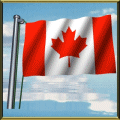On Friday last week, the Canadian government unveiled a CND$432 million (USD$362 million) program to increase border control and security along the border with the United States. This was immediately after plans by the U.S. were revealed to have unmanned spy planes patrolling the border and only about one week before passports become mandatory for U.S. residents to cross the border by plane.
The major border security initiative by the Canadian government will be implemented over the next five years, and with the aim of protecting the border from terrorist, economic and environmental threats.
Public Safety Minister Stockwell Day made the announcement on Friday at the Canada-U.S. border crossing between Windsor and Detroit, where one-third of the USD$1.6 billion in daily trade between the two countries crosses the border daily.
This one contact point between the neighbors exceeds the total trade between the U.S. and Japan.
18,000 trucks cross the U.S.-Canada border each day. As well, all railroad, air and marine cargo carriers will eventually have to file electronic manifests before their shipments arrive. This is expected to allow border service agents to decide in advance if a cargo, or those delivering it, should be screened more closely.
The eManifest program, which is part of the larger effort, will coordinate this effort and is expected to consume the bulk of the allocated funds (~USD$337 million). The electronic manifests will become mandatory at the 119 border crossings, but an exact target date is not yet announced.
When he was elected almost a year ago, Canada's Prime Minister, Stephen Harper, pledged to strengthen the frontier between the worlds largest trading partners.
The lack of security measures along both sides of the 8,890 kilometer (5,300 mile) border has been widely criticized, particularly since the terrorist attacks of 11 September 2001.
Passports and biometric identification
Another strategy is the joint Canadian-U.S. NEXUS traveler program, which allows low-risk travelers to cross the border more easily as long as they're willing to submit to a background check and provide fingerprints and other personal data.
NEXUS air, highway and marine programs were consolidated last month into a single 'trusted traveler' program. NEXUS, which started in 2002, now has more than 110,000 members in Canada and the U.S.
Canadians who want to join must pay an $80 fee, good for five years' membership, and supply proof of citizenship, admissibility and place of residence.
Those who have criminal records, who have violated customs or immigration law or are inadmissible to Canada or the United States under immigration rules are not eligible for the program.
The program is also being extended to Mexico to facilitate border crossings between the U.S. and its southern neighbor.
If accepted into NEXUS, a digital photo of a persons irises will be taken, which will be used to identify NEXUS members. Those who cross at land borders can use dedicated lanes, while marine travelers can report to border officials by phone.
A NEXUS membership will be recognized as an alternative to a passport under the U.S. Western Hemisphere Travel Initiative, which comes into force for air travelers on 23 January 2007.
In Canada, but especially in the United States, there is a backlog of people attempting to obtain passports. The requirement for air travelers to present a passport has been announced broadly since early last year.
The date has been moved several times, originally being expected to take effect from 01 January. Due to holiday travel concerns, it was extended twice until the present date was finalized late last fall. It currently applies to air travelers, but by 01 January 2008 it will apply to travelers by ship and by car.
Remote-control spy planes
The United States currently has a program in place to observe the U.S.-Mexico border with unmanned drones. Called Unmanned Aerial Vehicles (UAVs), they are based upon military spy planes and are being increasingly adapted for remote-control border patrol operations around the world.
Planned for sometime late this summer, the first UAVs will officially take flight to patrol the U.S.-Canada border. The first one on the northern border will be a single General Atomics Aeronautical Systems (GA-ASI) MQ-9 Predator 'B' aircraft.
Four Predator Bs are expected to be in operation by September, at a cost of just over USD$16 million each with USD$10 million in annual maintenance funding for the program. Known as "The Reaper," it is a new, improved version of the UAV used by the U.S. military in Afghanistan operations with "enhanced capabilities."
In parallel, new satellite-to-ground communications infrastructure will be developed at an existing air and marine operations centre at Riverside, California. At an estimated cost of $105 million, the communications system is designed to allow improved co-ordination of UAVs operated throughout U.S. national airspace to watch all borders.
UAVs used on the Canadian border will operate out of existing U.S. National Guard facilities at Grand Forks, North Dakota. This is the first step to lay the foundation for expanded Unmanned Aircraft System (UAS) operations along the nation's northern border.
In September 2006, officials of the U.S. Homeland Security Department unveiled plans for an array of sensors, infrared cameras, watchtowers and drones that will eventually monitor the country's entire border with Canada. The goal, they said, was to have the world's longest undefended border under surveillance within three to six years.
"What we are looking to build is a virtual fence, a 21st-century virtual fence," U.S. Homeland Security Secretary Michael Chertoff said at the time.
thxs workpermit.com



1 comment:
That was a good news! It will going to be more easy to apply for Canadian Visa if they keep improving. So the applicant's will no longer wondering how long it will takes.
US Waivers For Canadians
Post a Comment